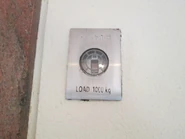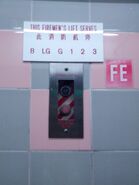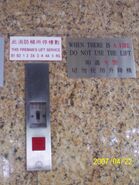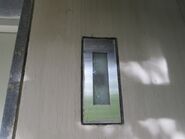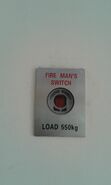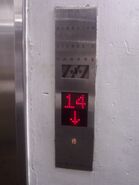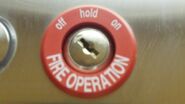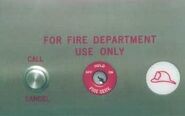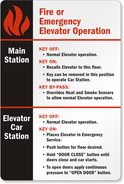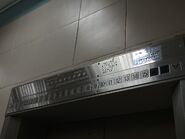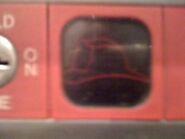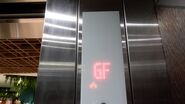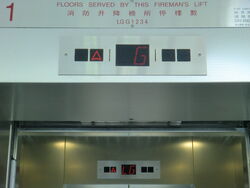
A sign indicate that is a Fireman's elevator. That is also a normal Kone passenger elevator when it not in fire service mode.[1]
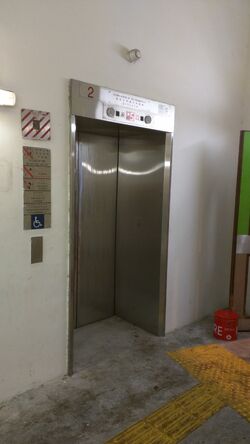
A lobby to be used in case of fire only, with the sign indicate that is a Fireman's elevator (hence there contains fireman's switch and floor indicator only and no call buttons in the lobby). That is also a normal Sigma passenger elevator when it not in fire service mode while the entrance in normal mode is on the other side.
Fireman's elevator (or Firefighter's elevator in the United States, Firefighter's service elevator in Japan[2]) is a type of elevator which enables firefighters to use in order to rescue people who may be trapped on upper floors during an event of fire in a building. Fireman's elevators are typically a normal passenger or service/freight elevators, and they have the fireman's service mode activated by a keyswitch (for United States, Australia, Germany, etc.) or a toggle switch (for countries in Asia and United Kingdom).
Fireman's elevator typically identified by a sign says FIREMAN LIFT, FIREMAN'S LIFT[3], FIREMEN'S LIFT, FIREMAN'S ELEVATOR, FIRE LIFT, FE in Mitsubishi elevator[4], "消防(員/用)升降機" in Chinese[3] or "非常用エレベーター" in Japanese.
In Australia (and sometimes Hong Kong, China), some fireman's elevators are designed to allow passengers to use them as part of fire evacuation procedures. They are known as "Protected Elevators" or "Evacuation Lift" ("逃生升降機" in Chinese)[5], and have to meet extra standards and reinforcement to keep passengers safe in an emergency[6].
Unless the usage of the fireman's elevators are permitted or granted by the firefighters, should use the evacuation staircases safely for evacuation when the building got fire.
Requirement for fireman's elevator
Hong Kong's code of practice[7][8]

These key switches are used for the floor lock out in one of the Schindler hydraulic fireman's elevator. These become invalid when the fire service mode active.
- At least 680kg (9 persons) capacity.
- At least 1.1m width on every side of the car and 1.35m2 available car space.
- At least 800mm width and 2m height for doors.
- Elevator doors must be automatic (close).
- Any doors and gates locked with key is prohibited unless they can unlock when the fireman's service mode active.
- Only 3 fireman's elevators or less can be accommodated in the same shaft and cannot accommodate any normal elevators (which cannot active the fireman's service mode).
- Two power supply is needed, normal and emergency power generator (applied in the buildings built in 1980s or later).
- Fireman's elevator must be finished in whole trip within one minute.
How it works
Active by a keyswitch
Fireman's elevator operates in two phases; Phase One and Phase Two. In Phase One, activated smoke detectors or hallway keyswitches direct elevators to go to a fire recall floor. Elevators traveling away from this designated landing reverse direction and proceed without stopping. Upon reaching the designated landing, passengers are able to exit the elevator and building safely. The elevators are then removed from normal service. Once removed from normal service, the elevators will no longer accept car or hall calls.
During Phase Two, once the elevator has reached its designated landing and all passengers are safely evacuated, firefighters can take exclusive control of the elevator using a special Firefighter’s Service Keyswitch. This mode of Fire Service allows firefighters to continue to utilize the elevator to rescue people from other floors.
Active by a toggle switch
Fireman's elevator operates in one phase only. If the toggle switch (or triangle-shaped toggle keyswitch) active, the designated fireman's elevator will go to a fire recall floor (the smoke detectors and fire alarm system also done this as well[9]). Elevators traveling away from this designated landing reverse direction and proceed without stopping. Upon reaching the designated landing, passengers are able to exit the elevator and building safely. The elevators are then removed from normal service. Once removed from normal service, the elevators will no longer accept hall calls. when the firefighters get in the elevator will don't need to use a special Firefighter’s Service Keyswitch because it already active by a toggle switch. This mode of Fire Service allows firefighters to continue to utilize the elevator to rescue people from other floors because it will stop at the nearest floor by the firemen registered and call cancelled automatically (if other floors was registered before the elevator arrived the nearest floor).
Voice messages when fire recall is activated
- "發生火警,請立即離開 (Cantonese), 發生火災,請立刻離開 (Putunghua), Fire! exit immediately (English)" - elevators installed in the Hong Kong Mass Transit Railway (MTR) stations.[10]
- "消防警鐘已啟動,請勿使用升降機 (Cantonese), 火警信號響起,當機門打開後,請離開升降機 (Putunghua), Fire alarm actuated, please don't use the lift (English)" - Applied for some of the Toshiba elevators in Hong Kong or Macau.
- "Lift required for emergency, please leave when the lift doors open" - elevators installed with the Drucegrove Digitalker lift speech announcer (mainly Otis elevators in the United Kingdom)[11].
- "It's needed for an emergency, please exit when the doors open" - American Otis elevator since 2000s[12].
- "Fire! Please leave when the elevator doors open." - Kone elevators installed since 2000s[13][14].
- "This lift is returning under fire service" - elevators equipped with International Lift Equipment SerComms[15] and SkyCom voice module.
- "(Dong ding x2) Please exit the lift when the doors opening" - Mitsubishi elevators installed since 2000s[16].
Gallery
Fire switches
- See also: Elevator fireman switch guide
Toggle/push switch
Keyswitch
Signs
Other
Videos
Notes and references
- ↑ Kone Traction Elevator at Car Park, Choi Fook Estate, Kowloon Bay, Kowloon, Hong Kong
- ↑ 非常用エレベーター
- ↑ 3.0 3.1 Fireman's lift (hkelev.com)
- ↑ Mitsubishi Electric Elevator Features Vocabulary
- ↑ New ‘lift only’ MTR station entrances
- ↑ Travelodge Docklands, Melbourne - Schindler High-Speed Elevators (Protected)
- ↑ Code of Practice for the Provision of Means of Access for Firefighting and Rescue 2004 (Building Department, Hong Kong, China, December 2004).
- ↑ Code of Practice for Fire Safety in Buildings 2011 (Building Department, Hong Kong, China, September 2011, revised in October 2015).
- ↑ Fire alarm 消防警鐘
- ↑ *港鐵港島綫西延 - 香港大學站山道 (B2) 出口升降機進行「火警演習」
- ↑ Eastfields part 4 | IT'S LIFT TOUR TIME!
- ↑ Otis Elevator Voice Announce Vocabulary
- ↑ Lift adventure in Coventry
- ↑ KONE Elevator Glossary - ACU elevator announcer
- ↑ ILE SERCOMMS almost complete libary
- ↑ Detailed look at Mitsubishi MRL
See also
External links
- Fireman's elevator perspective (PDF file)
- hkelev - Fireman's lift (Applied in Hong Kong) (translated version) (Original version)
- Elevator_Recall-Shutdown (rpsa_2010_rev_5)



